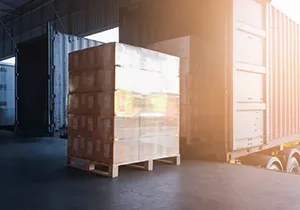When pallet shipments arrive at the warehouse, many different procedures occur based on what the shipment is and how it will be stored and shipped out later to fulfill orders. Two warehousing strategies are called cross-docking and transloading. Both have various steps in the process when the shipments arrive. Let’s learn more about these differences so you can select the one that best fits your operations.
What is Cross-Docking?
Cross-docking involves the storage of goods for very short periods of time. The pallets are not broken down, sorted, or placed onto shelves. Instead, they are often moved to a holding area or placed on the distribution dock to wait for another truck to transport them to a specified destination. This process is mainly used to redirect goods to other locations on demand, often for items that are time-sensitive, for emergency use, or perishable.
Benefits of Cross-Docking
The benefits of cross-docking strategies are that these methods save time and lower warehouse storage costs. Once the shipment arrives, it either goes onto another truck immediately or sits in the holding area to go out later that day. Another advantage is that it allows you to consolidate shipments which can save your company both labor and transportation costs. Workers are able to focus on other tasks without needing to break down the pallet shipment, place the stock on shelves, or pick and pack shipments.
What is Transloading?
Transloading is considered a part of an intermodal shipment method. The shipment takes more than one mode of transportation, such as boat to truck, truck to rail, or truck to air. It may also involve international or overseas travel. When the pallet arrives at the warehouse, it undergoes additional processing before being shipped out again.
At the warehouse, the pallet is opened and the goods are sorted based on destination and order requirements. Then the reorganized goods are placed on new pallets and become shrink-wrapped. The pallet may be placed into warehouse storage or wait on the distribution dock to go out on its next mode of transportation.
Benefits of Transloading
Transloading offers a repacking option for shipments that may not be ready for delivery due to needing assembly or to be grouped with other products that must be shipped out together. It also provides longer transportation methods and additional modes of transport that can provide transportation cost savings. Shipments are able to travel farther as your company can select additional routes. Warehouses that offer transloading services can help companies streamline their supply chains when receiving pallets by consolidating shipments at one location and then reorganizing them all in one service.
Your Warehousing Provider
At American Warehouse, Inc., we are a 3PL offering warehousing, distribution, and fulfillment services for small businesses as well as international companies. We provide the logistical strategies to help manage and streamline a company’s supply chain. Learn more by contacting us today.

